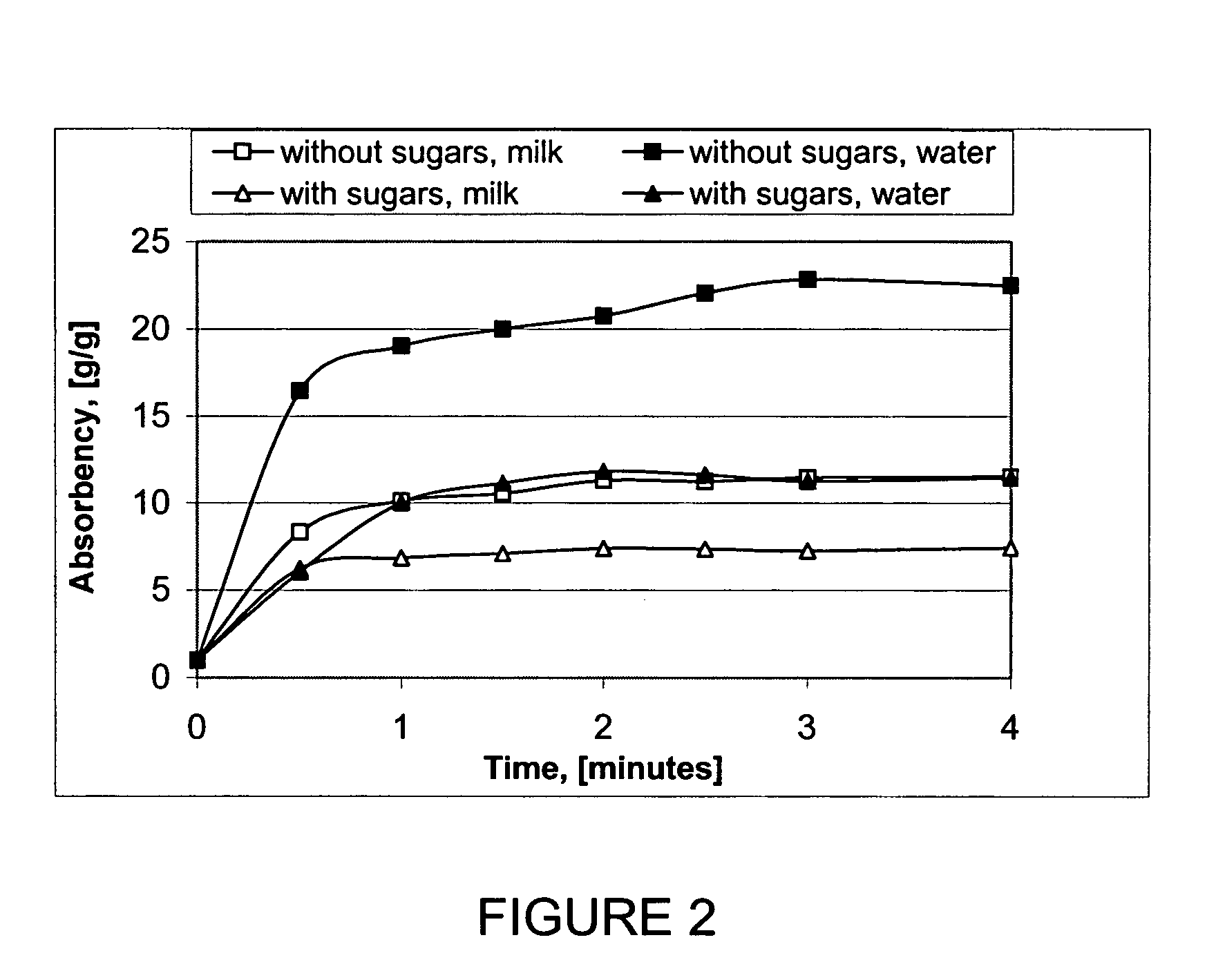Gelled biopolymer based foam
a biopolymer and foam technology, applied in the field of gelled biopolymer foam, can solve the problems of brittle foam, difficult to manufacture, difficult to handle, etc., and achieve the effects of low foam size control, and high production cos
- Summary
- Abstract
- Description
- Claims
- Application Information
AI Technical Summary
Benefits of technology
Problems solved by technology
Method used
Image
Examples
example 1
[0155] This example illustrates preparation of foams of different density, flexibility, and absorbency by varying the high speed blending time.
[0156] Following the general procedure, gelled foams containing 2% PROTANAL® SF 200 alginate, 10% glycerin, 0.3% CaCO3 (Merck), 2% HPMC, 1.06% GDL, and the balance deionized water. Aeration time was varied as shown in Table 1. During preparation, approximately one third of the water added with the GDL mixture. The dried gelled foams were not preconditioned. Properties for the foams are shown in Table 1.
TABLE 1Gelled foam density and absorbencyas a function of blending timeHigh SpeedWet foamDry foamDry FoamAbsor-BlendingDensityDensityWeightbencyAbsorbencyTime (min)(g / cm3)(g / cm3)(g)(g / g)(g / 100 cm2)a1.50.320.0861.5110.9422.00.250.0781.3713.4482.50.210.0691.1212.5393.00.170.0551.0310.5263.50.160.0460.879.821
aAmount of fluid absorbed by 100 cm2 of dried gelled foam 5 mm thick.
[0157] The absorbency of the foams was highly controlled by the blen...
example 2
[0159] This example illustrates modification of the foam integrity by adjusting the levels and ratio between calcium and alginate. Following the general procedure, gelled foams were prepared with 2% PROTANAL® SF200 alginate, 10% glycerin, 0.6% TWEEN® 20 and 2% HPMC using different calcium concentrations at a constant ratio of GDL and CaCO3 (Merck). A Silverson mixer was used in place of the Hobart mixer. The procedure used the same order of ingredient addition as was used when a Hobart mixer was used, but with 4 min of high speed mixing. The first minute of high speed mixing after the GDL addition was without addition of air. To decrease the wet foam density, air was added using a subsurface air stream for 3 min while mixing. The dried gelled foams were not preconditioned before determination of absorbency.
[0160] An alternative absorbency test was used in which gelled foam discs about 1.2 cm in diameter were soaked in saline solution at room temperature. Results are presented in Ta...
example 3
[0164] This example illustrates preparation gelled foams with higher solids content using a lower molecular weight alginate. Gelled foams were prepared as in Example 2. The formulation used 3.6% PROTANAL® LF20 / 40 alginate, 10% glycerin, 0.6% TWEEN® 20, 2% HPMC, 0.41% CaCO3 (Merck), 1.440 / a GDL with deionized water to 100%. Foams cast from wet foam with a density of 0.36 g / mI gave dry gelled foams with a density of 0.08 g / cm3.
[0165] The dried gelled foams were not preconditioned. The alternative absorbency test was used in which gelled foam discs about 1.2 cm in diameter were soaked in saline solution at room temperature. Absorbency was 11.30 g / g after 30 sec and 12.07 g / g after 5 min. The gelled foams had excellent integrity with a rating of 4.
PUM
| Property | Measurement | Unit |
|---|---|---|
| Fraction | aaaaa | aaaaa |
| Fraction | aaaaa | aaaaa |
| Fraction | aaaaa | aaaaa |
Abstract
Description
Claims
Application Information
 Login to View More
Login to View More - R&D
- Intellectual Property
- Life Sciences
- Materials
- Tech Scout
- Unparalleled Data Quality
- Higher Quality Content
- 60% Fewer Hallucinations
Browse by: Latest US Patents, China's latest patents, Technical Efficacy Thesaurus, Application Domain, Technology Topic, Popular Technical Reports.
© 2025 PatSnap. All rights reserved.Legal|Privacy policy|Modern Slavery Act Transparency Statement|Sitemap|About US| Contact US: help@patsnap.com


